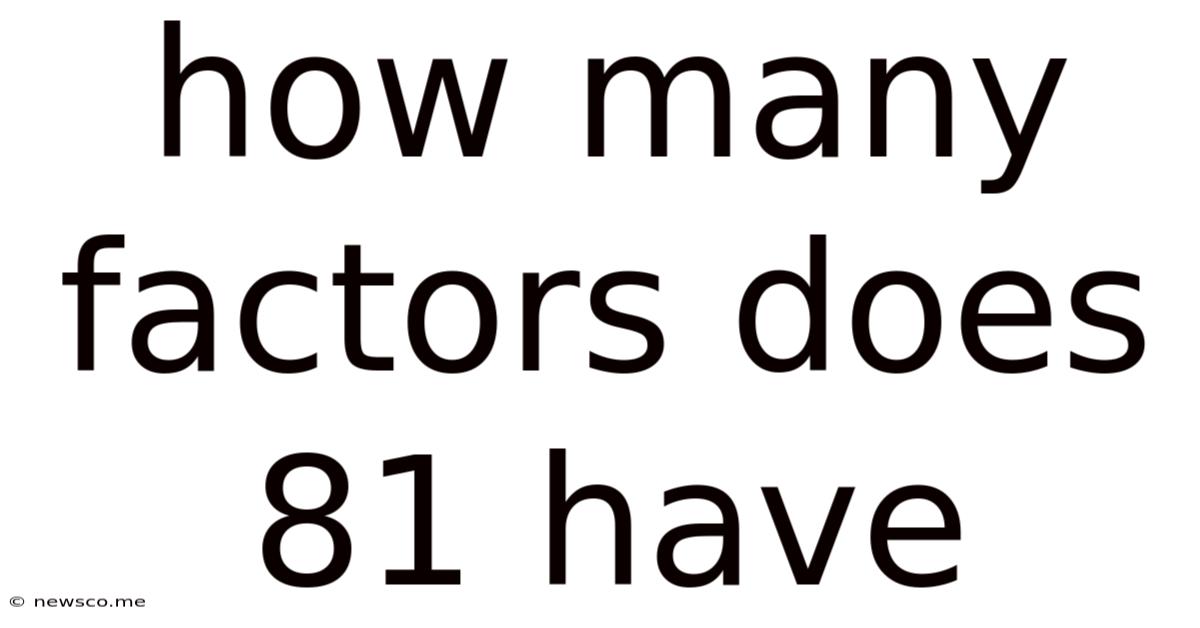How Many Factors Does 81 Have
News Co
Apr 23, 2025 · 4 min read

Table of Contents
How Many Factors Does 81 Have? A Deep Dive into Prime Factorization and Divisibility
Finding the number of factors for a given integer might seem like a simple mathematical task, but it opens a door to a fascinating world of number theory. This article delves into the question, "How many factors does 81 have?" We'll explore the concept of prime factorization, explain different methods for finding the number of factors, and even extend the discussion to more complex scenarios. By the end, you’ll not only know the answer but also understand the underlying mathematical principles.
Understanding Prime Factorization
The cornerstone of determining the number of factors of any number is its prime factorization. Prime factorization is the process of expressing a number as a product of its prime factors. A prime number is a whole number greater than 1 that has only two divisors: 1 and itself. Examples include 2, 3, 5, 7, 11, and so on.
Let's find the prime factorization of 81:
- We can start by dividing 81 by the smallest prime number, 2. Since 81 is odd, it's not divisible by 2.
- Next, we try 3: 81 ÷ 3 = 27.
- Now we have 81 = 3 × 27. 27 is also divisible by 3: 27 ÷ 3 = 9.
- This gives us 81 = 3 × 3 × 9. 9 is divisible by 3: 9 ÷ 3 = 3.
- Finally, we have 81 = 3 × 3 × 3 × 3.
Therefore, the prime factorization of 81 is 3<sup>4</sup>.
Calculating the Number of Factors
Once we have the prime factorization, calculating the total number of factors becomes straightforward. The method involves using the exponents of the prime factors.
For a number with prime factorization p<sub>1</sub><sup>a</sup> × p<sub>2</sub><sup>b</sup> × p<sub>3</sub><sup>c</sup>..., where p<sub>1</sub>, p<sub>2</sub>, p<sub>3</sub>... are distinct prime numbers and a, b, c... are their respective exponents, the total number of factors is given by:
(a + 1)(b + 1)(c + 1)...
In the case of 81 (3<sup>4</sup>), we have:
- a = 4 (the exponent of the prime factor 3)
- Therefore, the number of factors is (4 + 1) = 5
So, 81 has five factors.
Listing the Factors of 81
Let's verify our calculation by listing all the factors of 81:
- 1: Every number is divisible by 1.
- 3: 81 ÷ 3 = 27
- 9: 81 ÷ 9 = 9
- 27: 81 ÷ 27 = 3
- 81: 81 ÷ 81 = 1
We see that there are indeed five factors: 1, 3, 9, 27, and 81.
Extending the Concept to Other Numbers
Let's apply this method to other numbers to solidify our understanding.
Example 1: Finding the factors of 36
- Prime factorization of 36: 2² × 3²
- Number of factors: (2 + 1)(2 + 1) = 9
- Factors: 1, 2, 3, 4, 6, 9, 12, 18, 36
Example 2: Finding the factors of 100
- Prime factorization of 100: 2² × 5²
- Number of factors: (2 + 1)(2 + 1) = 9
- Factors: 1, 2, 4, 5, 10, 20, 25, 50, 100
Example 3: A number with more than two distinct prime factors - 72
- Prime factorization of 72: 2³ × 3²
- Number of factors: (3 + 1)(2 + 1) = 12
- Factors: 1, 2, 3, 4, 6, 8, 9, 12, 18, 24, 36, 72
Perfect Squares and the Number of Factors
Notice a pattern? Perfect squares, like 81 (9²), 36 (6²), and 100 (10²), often have an odd number of factors. This is because one of the factors is the square root of the number itself. For example, 9 is a factor of 81. This characteristic doesn't hold true for numbers that aren't perfect squares.
Advanced Concepts: Divisibility Rules and Factor Trees
While prime factorization is the most efficient method for larger numbers, understanding divisibility rules can help speed up the process for smaller numbers. Divisibility rules provide shortcuts to determine if a number is divisible by a certain prime number without performing the division.
Additionally, factor trees offer a visual representation of the prime factorization process. A factor tree starts with the number you want to factor and branches out into its factors. This process continues until all the branches end in prime numbers.
Conclusion: Mastering Factorization
Understanding how to determine the number of factors of a given integer is a fundamental skill in number theory. By mastering prime factorization and the formula for calculating the number of factors, you can efficiently solve this type of problem for any integer, regardless of its size or complexity. This knowledge extends beyond simple number theory, finding applications in various fields like cryptography and computer science. Remember to practice with different numbers to build your proficiency and deepen your understanding of this core mathematical concept. The seemingly simple question, "How many factors does 81 have?" unveils a rich tapestry of mathematical relationships and problem-solving techniques.
Latest Posts
Related Post
Thank you for visiting our website which covers about How Many Factors Does 81 Have . We hope the information provided has been useful to you. Feel free to contact us if you have any questions or need further assistance. See you next time and don't miss to bookmark.